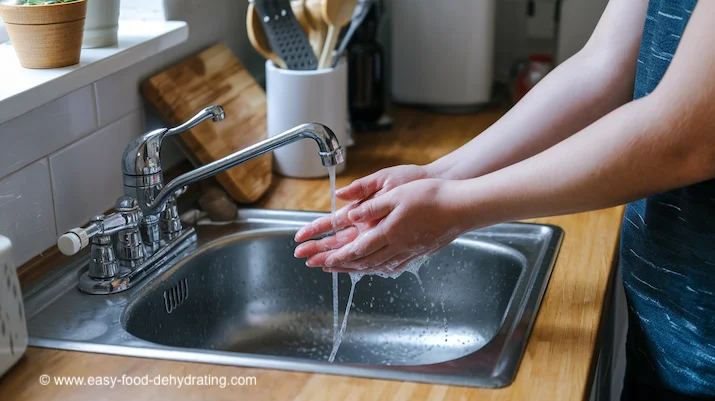What We Mean by “Dehydrate”
Here at Easy Food Dehydrating, “dehydrate” always means using an electric food dehydrator — the easy, reliable way to dry food at home.
- Home
- Articles On How To Dehydrate Food Safely
- Food Dehydrator Safety: Cross Contamination Guide
Food Dehydrator Safety
Cross Contamination Guide

Food dehydration is a fantastic way to preserve fruits, veggies, and meats - but without proper safety practices, bacteria can hitch a ride from one food to another. That’s why understanding cross-contamination isn’t optional; it’s the foundation of safe dehydrating.
✅ Quick Answer: How do you prevent cross-contamination when using a food dehydrator?
Prevent cross-contamination by using separate cutting boards for meats and produce, cleaning trays and surfaces thoroughly after each batch, and choosing a dehydrator with easy-to-clean stainless steel trays and removable drip pans. Good hygiene and routine cleaning are the keys to safe dehydrating.
In this guide, you’ll learn exactly how to keep harmful germs at bay with smart prep, cleaning routines, and equipment choices - so every batch you make is safe, tasty, and long-lasting.
How to Stop Cross-Contamination Before It Starts

You'll learn about proper equipment selection, essential cleaning protocols, and the science behind keeping your dried foods safe and delicious.
What Cross-Contamination Really Means for Dehydrating
Why Dehydration Alone Won’t Kill All Bacteria
Think of cross-contamination as the ultimate party-crasher in your kitchen. It's when uninvited bacterial guests hop from one food to another through direct contact or indirect means - like using the same cutting board for your raw chicken jerky and then for cutting up your mangoes.
While dehydrating does make life harder for bacteria (they're not fans of dry environments), it's not a guaranteed knockout punch.
I've seen plenty of well-meaning food preservers make the same assumption I once did - that the dehydration process is some kind of bacterial death ray that eliminates all risks.
The truth? Proper handling before, during, and after drying is just as important as the drying itself.
Sneaky Ways Cross-Contamination Creeps Into Your Dehydrator
Let's go through some of the most common ways cross-contamination occurs. Trust me, I've encountered most of these myself - sometimes in ways I'd rather not mention. (Mold).
The Cleaning Step You Can’t Skip Between Batches
Here's a fun fact that's not actually fun: meat proteins can linger in your dehydrator's nooks and crannies longer than you'd like.
The real issie? These protein remnants aren't just a flavor issue - they can harbor bacteria that would love nothing more than to meet your next batch of dried pineapple.
And don't even get me started on what happens when you dry onions and then try to make fruit leathers. Unless you're aiming for onion-flavored fruit roll-ups (please don't), thorough cleaning between batches isn't just nice - it's necessary.
Features That Make a Dehydrator Truly Safe
Your dehydrator's design plays a bigger role in food safety than you might think. Those budget-friendly models with heating elements at the bottom? They can act as catch-basins for drips and drops from whatever you're drying.
I learned this the hard way when my bottom-heated dehydrator turned into a marinade collection system during a jerky-making session.
Here's what I've discovered works better:
- Top or back-mounted heating elements (everything flows down away from them)
- Models with removable drip trays (catch trouble-making drips before they cause problems)
- Stainless steel trays vs. using plastic ones (plastic can develop micro-scratches that can host bacteria)
Prep Like a Pro: Cutting Board & Container Safety
A cutting board used for raw meat can harbor bacteria for days if not properly sanitized.
Your best bet? Create a cutting board color-coding system:
- Red for raw meat (think: red meat = red board)
- Green for fruits and veggies (nature's color green = nature's bounty)
- White for ready-to-eat foods (think white = pure and clean)
Beyond Handwashing: Hygiene Habits That Matter Most

Everyone knows about washing hands, but proper hygiene in food dehydration goes way beyond that quick lather and rinse at the sink.
Let's break down what really matters when you're preparing food for dehydration.
Set Up a Prep Area That Stops Germs in Their Tracks
Before you even think about slicing that first apple or marinating that first strip of beef, your prep area needs to be ready. I keep a dedicated dehydrating station in my kitchen with:
- A clean, sanitized countertop space
- Separate cutting boards for different food types
- Pre-labeled containers for marinades and spice mixes
- A supply of food-grade gloves within easy reach
Think of it as creating a mini commercial kitchen setup.
Having everything in its place prevents those "oops" moments when you're handling raw meat and suddenly need to grab something from across the kitchen.
Smart Pre-Treatments That Boost Safety and Flavor
Some foods need special treatment before dehydrating to prevent contamination and ensure safety. Here's a simple system:
For Fruits:
- An ascorbic acid dip prevents browning and adds an extra layer of protection
- Citric acid solutions work well for fruits like apples and pears
- Even a simple lemon juice bath can make a difference
For Vegetables:
- Steaming kills surface bacteria and brightens colors
- Water blanching works well for denser vegetables
- Some items, like onions and garlic, can skip pre-treatment
For Meats:
- Marinades should always be prepared and stored separately
- Use one container for raw meat marinades and another for finished products
- Never reuse marinades unless they've been fully boiled first to kill germs
Tools and Gear That Make Dehydrating Safer
See my Food Dehydrating Starter Kit for suggested tools and dehydrators, and what size of oxygen absorbers and desiccant packets you need to get started.
Must-Have Dehydrator Features for Food Safety
The market has tons of options, but here's what experienced food preservers look for:
Airflow Pattern:
- Vertical airflow models may reduce flavor transfer between trays
- Horizontal flow units are excellent for even drying (but I still rotate the trays!)
- Box-style dehydrators with rear-mounted fans provide the most consistent results
Temperature Control:
- Digital controls offer precision you can't get with dial systems
- Look for units that maintain temperature within 5 degrees
- Built-in thermometers help verify actual drying temperatures
Materials and Construction:
- Stainless steel trays are easier to sanitize than plastic trays
- BPA-free components are essential for food safety
- Removable mesh plastic or silicone screens prevent food from sticking and simplify cleaning
The Simple Add-On That Prevents Hidden Contamination
One of the most useful tips I've discovered is placing a solid fruit leather tray at the bottom of your dehydrator.
It's like having an insurance policy against drips and spills.
This simple addition:
- Catches marinades and fruit juices before they reach the heating element
- Makes cleanup significantly easier
- Lessens cross-contamination between batches
- Extends the life of your dehydrator
Cleaning Routine That Keeps Your Dehydrator Germ-Free
A well-maintained dehydrator isn't just about making it last longer - it's about consistent, safe results. Here's my routine:
Daily Cleaning:
- Wash trays immediately after use with hot, soapy water
- Wipe down interior walls and fan housing
- Check and clean any filters or screens
Weekly Maintenance:
- Deep clean all components
- Inspect seals and gaskets
- Check temperature accuracy with an independent thermometer
Monthly Check-up:
- Test heating element performance
- Clean hard-to-reach areas like fan blades (if accessible/visible)
- Examine trays for wear or damage
Final Safety Reminders Every Dehydrator Should Know
Whether you're making jerky one day and dried fruits the next, success comes down to proper equipment selection, thorough cleaning practices, and consistent attention to food safety basics.
Remember these key points:
- Choose equipment designed for easy cleaning and maintenance
- Establish clear cleaning protocols between different types of foods
- Pay attention to temperature requirements for drying different foods
- Never skip cleaning steps, even when in a hurry
- Invest in proper tools and separate them by food type
Most importantly, don't let concerns about cross-contamination discourage you from trying different types of dehydrated foods.
With proper precautions and practices, your dehydrator can safely handle everything from beef jerky to banana chips. Just remember that each successful batch starts with clean equipment and good safety habits.
Ready to take your food dehydration practice further? In our companion storage maintenance guide here, we'll explore proper storage techniques, daily maintenance routines, and troubleshooting tips to ensure your dried foods remain safe and delicious for months to come.
Your Cross-Contamination Safety Questions, Answered
What is cross-contamination in a food dehydrator?
What is cross-contamination in a food dehydrator?
Cross-contamination happens when bacteria from raw foods (like meat) spread to fruits, veggies, or ready-to-eat items through shared trays, cutting boards, or improper cleaning.
Can I dehydrate meat and fruit in the same dehydrator?
Can I dehydrate meat and fruit in the same dehydrator?
Yes, but you must clean trays, drip pans, and all surfaces thoroughly between batches to prevent bacteria transfer and unwanted flavor mixing.
Do I really need separate cutting boards for dehydrating?
Do I really need separate cutting boards for dehydrating?
Absolutely. Use color-coded boards — red for raw meat, green for produce, white for ready-to-eat foods — to avoid bacterial spread.
What type of dehydrator is safest for preventing cross-contamination?
What type of dehydrator is safest for preventing cross-contamination?
Look for dehydrators with top or rear-mounted fans and heating elements, since these keep drips away from the heat source. Bottom-mounted models are fine too if they’re designed with a solid drip tray to catch juices. Most consumer dehydrators use BPA-free plastic trays, which are perfectly safe as long as they’re cleaned thoroughly. Stainless steel trays are easier to sanitize and longer lasting, but they’re less common and usually more expensive.
How often should I clean my dehydrator?
How often should I clean my dehydrator?
After every use. Wash trays with hot, soapy water, wipe down the interior, and check for trapped residue, especially after drying meats or sticky fruits.
Cross-contamination might sound intimidating, but with the right habits it’s easy to keep under control. From separating cutting boards to cleaning trays after each batch, these small steps protect your health and make dehydrating more enjoyable.
Before you head off to try your next recipe, don’t forget to grab the free 5 Dried Food Recipes You’ll Actually Love PDF (below). Inside, you’ll find tasty ideas like carrot soup, split pea soup, spicy beef jerky, and even banana cinnamon rolls — the perfect way to put your safe dehydrating skills into practice!
Get 5 Dried Food Recipes You'll Actually Love
Here's where you can get your copy of our all new
5 Dried Food Recipes (That Actually Taste Great)
They're my all-time favorite easy dried food meals!
Get it here right now.
For Free!
Before You Go...
If you enjoyed this page, tap the ❤️ in the lower right-hand corner.
It saves this page to your Grow bookmarks so you can find it again later.
You’ll also see quick share buttons to copy the link, post to Facebook,
or save it straight to Pinterest.
















